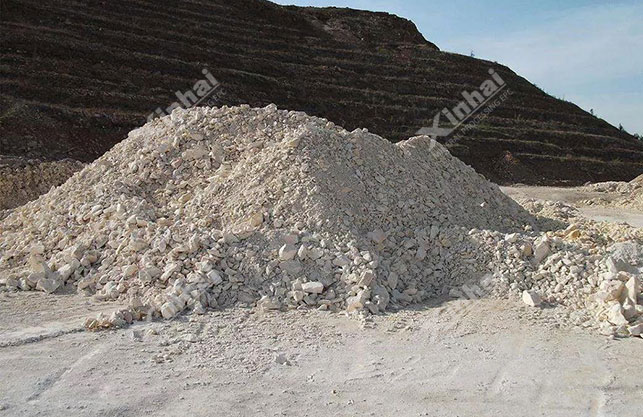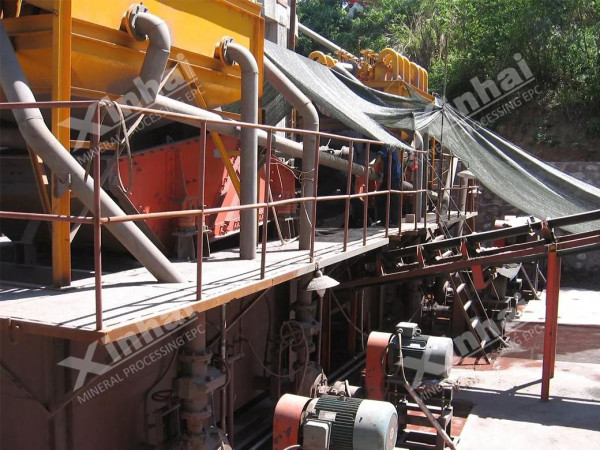Kaolin, also known as dolomite, is a common clay mineral in nature. Kaolin is a useful mineral for making white pigment, and whiteness is the main performance parameter affecting the value of kaolin. The kaolin often contains iron, organic matter, dark substances and other harmful impurities, which will make the kaolin appear different colors and affect its whiteness. Therefore, the impurities of kaolin must be removed before use.

Common methods for purification of kaolin include gravity separation, magnetic separation, flotation, chemical treatment, etc. Here, we will introduce common methods for purification of kaolin:
The gravity concentration method mainly uses the density difference between gangue minerals and kaolin to remove the high-density impurities of light organic matter, quartz, feldspar, iron, titanium and manganese, so as to reduce the impact of impurities on whiteness. Centrifugal concentrators are usually used to remove high-density impurities. The hydrocyclone group can also be used to complete the washing and screening operations in the process of kaolin separation, which can not only achieve the purpose of washing and classification, but also remove some impurities, and has good application value.
However, it is difficult to obtain qualified kaolin products by gravity separation, and the final qualified products should be obtained by magnetic separation, flotation, calcination and other methods.

Almost all raw kaolin ores contain a small amount of iron minerals, generally 0.5% - 3%, mainly including magnetite, ilmenite, siderite, pyrite and other colored impurities. The magnetic separation method mainly uses the magnetic difference between gangue minerals and kaolin to remove these colored impurities.
For magnetite, ilmenite and other strong magnetic minerals or iron filings mixed in the processing, magnetic separation is more effective for separating kaolin. For weak magnetic minerals, there are two main methods: one is to calcine the minerals to make them become strong magnetic iron oxide, and then conduct magnetic separation; The other method is magnetic separation with high gradient and strong magnetic field. Because magnetic separation does not require the use of chemical agents, it will not pollute the environment basically, so it is widely used in non-metallic mineral processing. The magnetic separation method has effectively solved the problem of the development and utilization of low-grade kaolin that has no commercial mining value due to the high iron ore content. The superconducting magnetic separator has the characteristics of high field strength, energy saving, and large productivity, and can directly treat the kaolin with more impurities.
However, it is difficult to obtain high grade kaolin products only by using a single magnetic separation method. Chemical treatment and other processes are also needed to further reduce the iron content in kaolin products.

The flotation method mainly uses the difference in the physical and chemical properties of the surface between gangue minerals and kaolin to deal with raw kaolin ores with more impurities and lower whiteness, and remove their iron, titanium and carbon impurities, so as to realize the comprehensive utilization of low-grade kaolin resources.
Kaolin is a typical clay mineral, and iron, titanium and other impurity minerals are often embedded between the kaolin particles. Therefore, the raw ore must be ground to a certain fineness, and the particle size mostly belongs to the mud size particles mentioned in the flotation process. The common flotation methods of kaolin are superfine flotation, double liquid layer flotation and selective flocculation flotation.
Flotation method can effectively improve the whiteness of kaolin, but its disadvantage is that chemical reagents need to be added, resulting in higher production costs and easy to cause environmental pollution.
Chemical leaching: some impurities in kaolin can be selectively dissolved by sulfuric acid, hydrochloric acid, nitric acid and other leaching agents to remove impurities. The method can be used to remove hematite, limonite, siderite, etc. from low-grade kaolin.
Chemical bleaching: impurities in kaolin can be oxidized into soluble substances by bleaching, and then washed to remove, so as to improve the whiteness of kaolin products. However, the cost of chemical bleaching is relatively high, and it is usually used for kaolin concentrate that needs further purification after impurity removal.
Roasting purification: magnetic roasting, high temperature roasting or chlorination roasting can be carried out by taking advantage of the difference in chemical composition and reaction activity between impurities and kaolin to remove iron impurities, carbon impurities, sulfide and other impurities in kaolin. The method can improve the chemical reaction activity of calcined products, greatly improve the whiteness of kaolin, and obtain high-grade kaolin products. However, the disadvantage of roasting purification is that it consumes more energy and is easy to cause environmental pollution.
It is difficult to obtain high grade kaolin products only through a single process. Therefore, in actual production, it is recommended that all mine owners choose manufacturers with mineral processing qualifications to conduct mineral processing tests and adopt a combination of multiple processes to improve the quality of kaolin products.